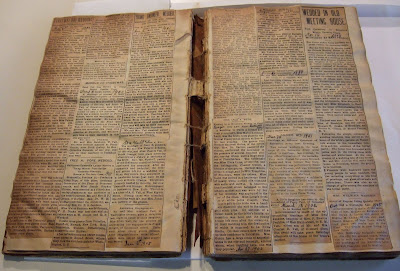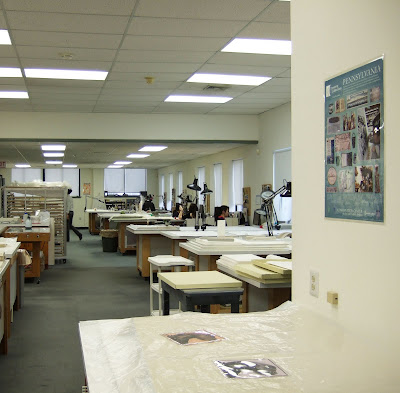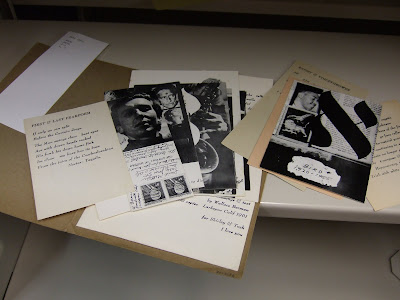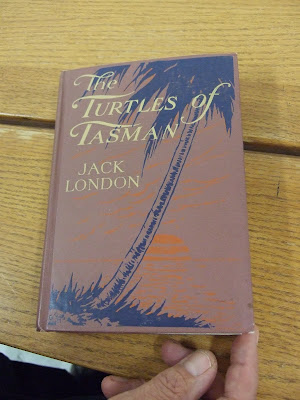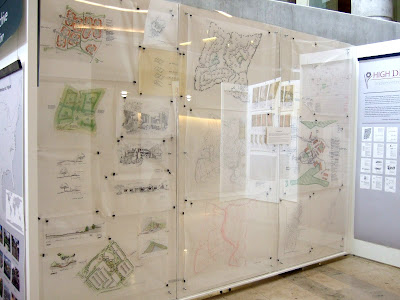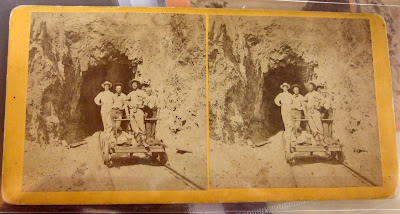 |
| From University of Arizona |
Introduction
During my April trip to Arizona, I looked forward to touring the University of Arizona’s Special Collections (in the Main Library whose exterior is shown above), especially the school’s book collections and the photographs. However, my time to visit shrank to 30 minutes due to an accident on the only major road between Phoenix and Tucson. An overturned tractor trailer had spilled a container-load of strawberries onto the freeway and caught fire about two miles ahead of me.
Once all the local radio stations had announced that the freeway was closed and I had been sitting in the desert sun for 25 minutes, I took out my cell phone and hoped for coverage. I saw a single, small bar on my phone and called my tour host, Chrystal Carpenter, who was very gracious and understanding. Unfortunately, by the time I arrived in Tucson (more than 2 hours late for our appointment), we didn’t have much time because her guest speaker for that night’s event was about to arrive at the airport and she needed to leave to collect him.
Despite the major snag, Chrystal gave me a great short tour and inspired me to return when we both have more time for a visit.
Background on the School
When I read the early history of the University of Arizona, I thought, "This is a story of the wild, wild West." It begins in 1885, when the Arizona Territorial Legislature convened in Prescott, the then-capitol, to discuss a variety of topics including where the territory’s insane asylum would reside and where the University of Arizona would be established. Those early settlers must have been very confident that Arizona would eventually become a state to start planning its university. Statehood didn’t occur until 1912.
The Tucson delegation intended to petition the Territorial Legislature to have the capitol moved from Prescott to Tucson. However, their wagons had gotten stuck in the mud from torrential rain, and they didn’t arrive until after the monies had already been divided. (Today, it takes between 4 and 5 hours to drive north from Tucson to Prescott – imagine how long it must have taken with a horse-drawn wagon on dirt roads and paths.) Because the Tucson delegation was so late, it missed out on the $100,000 that went with the asylum, and instead received $25,000 for the University of Arizona. Six years later, the school’s first student (a 14-year-old girl) signed her name in the registration book. Special Collections contributed materials to an excellent video about that girl’s experience with the school. Watch Clara Fish’s story here.
About the Archivist
 |
| From University of Arizona |
Allow me to introduce my affable and accommodating tour host, Chrystal Carpenter, the Manuscript & Congressional Archivist at the University of Arizona’s Special Collections. Chrystal has been in her current position for three years. Previously she served as the photo archivist at the Arizona Historical Society in Tucson, and an archives and library assistant at the Arizona State Museum. She earned her Master in Information Resources and Library Science from the University and later obtained her certification from the Academy of Certified Archivists.
She fell in love with the profession as an anthropology/archaeology undergraduate student at the University. Chrystal explains, "I had the opportunity to work at Special Collections, and it is here that I developed a passion for archives. I found that an archival career would be similar to an archaeological career except I wouldn’t get as dirty!"
While she knew she wouldn’t get as dirty, Chrystal certainly didn’t expect that she would be called in to oversee the collection of mementos and personal tributes to the victims of the January 8th attempted assassination of Congresswoman Gabrielle Giffords. Arizona Public Media’s interview below shows Chrystal describing her process of working with the many volunteers who helped collect and package the materials, as well as decisions she made about how to handle this collection. She also does an excellent job of explaining the archival process and Special Collections without being technical or jargony.
I asked Chrystal about her upcoming and current projects. She told me about some of the fascinating work she’s doing and the big projects on schedule for the summer.
A priority for Special Collections is our Borderlands Cultural Community project. With this in mind I have been working toward acquiring collections that fit its scope, as well as prioritizing our processing activities. This summer, we will be processing the Humane Borders archive as well as a bilingual education collection. I also will be integrating the Arizona Architectural Archives (AAA) into our collection. The AAA materials contain about 600 linear feet of architectural and business records and include over 22 collections that were curated by the University’s Architecture department.
I found Chrystal to be particularly impressive in the area of training. In an innovative move, she trained a subset of catalogers from Technical Services to provide archival processing services as well as their regular work. This initiative allowed her to add 100 hours a month of processing to Special Collections and yielded 2.5 full-time processors. Her work, as well as that of her colleague Erika Castano, also helped add value to the metadata of the digital collections and taught the catalogers highly marketable skills.
Exhibits and Public Outreach
 |
| From University of Arizona |
Whenever I visit an archive, university special collections, or any other cultural heritage institution, I am often intrigued by the displays and exhibits. The University of Arizona’s exhibit space (renovated in 2001) shown above and immediately below provides the archivists with a great deal of attractive, modern space where they show the role played by archival materials in history.
 |
| From University of Arizona |
The Special Collections department changes its exhibits every six months. At the time of my visit, the exhibit space focused on the life and impact of Stewart Lee Udall ("I’m for Stew" was its apt title). According to the Special Collections web site, he was an Arizona congressman who also served as Secretary of the Interior from 1961-1969 (under both Presidents John F. Kennedy and Lyndon B. Johnson). Udall was "a champion of civil rights, an avid conservationist, a lawyer, a B24 gunner during WWII, and a University of Arizona alumnus," says Special Collections. The next exhibit will focus on Arizona history from 1600-1912 in commemoration of the 2012 Arizona Centennial.
Remember Chrystal’s guest speaker for the night of my tour? He was the second speaker in a three-part lecture series on "Stew." Robert G. Stanton, Senior Advisor to the Secretary of the U.S. Department of the Interior and Director of the National Park Service from 1997-2001, spoke on Udall’s environmental work and how he became a leading voice in American environmentalism.
 |
| From University of Arizona |
The photo above shows the public reading room used for lectures like Stanton’s. There also is another large space inside Special Collections that is frequently used for meetings and other University events.
About the Collections
The University of Arizona’s Special Collections was established in 1958 to house materials on Arizona, the Southwest, and the U.S./Mexico Borderlands. Today it includes audio; video; film; cassettes; electronic records; photographs; and paper-based collections including personal and corporate records, sheet music, maps, and blueprints in a wide variety of areas.
The processed manuscript collections come in at about 12,000 linear feet and growing. The unprocessed materials are about 3000 linear feet and shrinking. Below is a photo of Special Collections’ unprocessed stacks.
 |
| From University of Arizona |
Because the University also has a library school, Special Collections makes use of paid graduate and undergraduate student assistants as well as interns to help the seven full-time and two part-time employees accomplish their work. Three of the seven full-timers are archivists.
Most of Special Collections’ patrons are associated with the University, whether undergraduates, graduates, faculty, and/or visiting researchers. However, Chrystal notes "We also have a number of researchers from around the country and internationally, as well as local users." They see approximately 50 visitors per week, and host a long-term researcher utilizing the political collections. "More often than not, our long-term researchers are working with our political collections, University-related materials, or early Tucson research," explains Chrystal.
Because the school is renowned for its astronomy, among other research areas, the Special Collections reflects that focus in its rare books holdings. Chrystal showed me a particularly interesting volume by Galileo, published in 1610. (She holds the volume in the photo above in "About the Archivist.") A researcher, who had located the book in World Cat discovered through his descriptive bibliography work that the book was one of three existing hand-edited works by the astronomer. Below are three photos of the book (the first is the title page, the second shows a hand-edited page, and the third is a close-up of the edit).
 |
| From University of Arizona |
 |
| From University of Arizona |
 |
| From University of Arizona |
The University of Arizona’s Special Collections also contain a small percentage of three-dimensional objects such as wigs, trunks, costumes, and paintings. Below are two examples of objects that are part of the school’s very popular American Vaudeville Museum collection and related vaudeville collections. First is a pair of pants decorated with shell buttons, worn by a vaudeville actor.
 |
| From University of Arizona |
Next is a box of wigs, also worn by vaudeville actors.
 |
| From University of Arizona |
Chrystal also showed me some of Special Collections’ Western Pulp Fiction holdings. Below is some of the creative labeling used for that collection. Following the photo is a very short video of Chrystal in the stacks talking about the Western Pulp Fiction.
Embed photo:
 |
| From University of Arizona |
Other popular Special Collections at the school include the Josias Joesler collection of architectural renderings and blueprints and the Stewart L. Udall and Morris K. Udall political collections. Chrystal’s favorite collections are the Stewart L. Udall and the Don Alonzo Sanford Collections. She likes Udall’s because it contains so much documentation "from his early life growing up in a rural Arizona town and his life as a WWII B-24 bomber, to the vast documentation on his eight years as the U.S. Secretary of the Interior," she says.
Chrystal is especially interested in the Don Alonzo Sanford collection because it "provides a snapshot into the everyday life of a pioneer businessman/politician and his family in the Arizona Territory--from what it would cost for Tucson to install street lights to what it was like for a Eastern woman to travel across country and take up residence in an unfamiliar western territory."
 |
| From University of Arizona |
Some of the undiscovered or underutilized gems of the collection include the incunabula holdings (books that were printed prior to 1501), science fiction and fanzines collections, and de la Torre family collection which focuses on the Cristero Movement in Mexico.
Conclusion
The University of Arizona’s Special Collections makes significant contributions to the effort to preserve the region’s collective historical memory. Its acquisition, processing, and digitization programs related to projects like the Borderlands Cultural Community program allow its archivists and librarians to work with community groups in the borderland region to acquire collective histories. With proactive and innovative leaders such as Chrystal Carpenter, the future of Special Collections looks especially bright.
Contact Information
Chrystal Carpenter
Manuscript & Congressional Archivist
University of Arizona Libraries, Special Collections
1510 E. University Blvd.
Tucson, AZ 85721
(520) 621-6423
carpenterc@u.library.arizona.edu
http://speccoll.library.arizona.edu/


